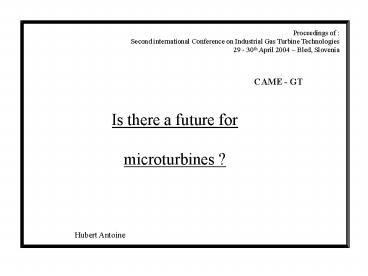Prsentation PowerPoint - PowerPoint PPT Presentation
1 / 21
Title:
Prsentation PowerPoint
Description:
... 25% for the high speed alternator (10%) and power electronics / control ... of design 4 becomes the alternator, power electronics and control system, this ... – PowerPoint PPT presentation
Number of Views:41
Avg rating:3.0/5.0
Title: Prsentation PowerPoint
1
Proceedings of Second international Conference
on Industrial Gas Turbine Technologies 29 - 30th
April 2004 Bled, Slovenia
CAME - GT
Is there a future for microturbines ?
Hubert Antoine
2
Existing situation The microturbine struggles
to create a distributed power market, and on the
existing cogeneration market, microturbines
presently suffer from the stiff competition of
Diesel and gas engines. The following factors
are often quoted to explain this situation ?
Microturbines are too expensive, compared with
reciprocating engines that have a two or three
times lower purchase price. ? The electrical
efficiency is too low at the current 30 level.
For the distributed power market, it should be at
least 40 to be economically profitable. It is
often difficult and expensive to transform the
rejected heat into cold during summer. ?
Reliability issues concerning the recuperator,
combustor and gas compressor have been mentioned
reciprocating engines are technically more
mature.
3
Future situation There is no doubt that the
microturbine will eventually overcome these
problems. The microturbine has the following
advantages compared with reciprocating engines
low maintenance, no vibrations, low weight, clean
exhaust. ? High specific power is a way to
reduce the size and cost of the system. ? High
volume production is only possible with a limited
use of strategic materials. ? High efficiency
ceramic gas turbine development is actively
pursued in Japan, US.
4
Microturbine Cost estimate The purchase cost
of a current 100 kW microturbine is usually
divided into (Ref.9) 1) 25 for the
powerhead 2) 25 for the recuperator 3) 25
for the high speed alternator (10) and power
electronics / control system (15) 4)
25 for the accessories gas compressor, hot
water generator, lubrication system, cooling,
silencing, casing, To evaluate how the
specific cost /kW may vary with the specific
power (SPPO, kJ/kg) of the turbine, let SP be
the ratio of the specific power of a given
turbine to the specific power of the reference
current 100 kW microturbine. ( SPPO about 120
kJ/kg)
5
(No Transcript)
6
(No Transcript)
7
75 kW recuperator
Diameter 720 mm
8
Evaluation of some cycles - all cycles
are recuperated , with 90 recuperator
effectiveness. - One stage radial turbine
it is able to expand to up to 201 in one stage,
if ceramic. - The pressure ratio P of each
cycle is adjusted to give the best combination of
hth and SPPO - Max TET 1700 K for
limited NOx generation - Max allowable gas
temperature at recuperator entry 700 C this
allows the use of a cheap and reliable stainless
steel recuperator - Compressor hpol 82,
turbine hpol 83 - The high
temperature alloy cost and ceramic cost are equal
per volume. - A ceramic turbine can stand
TET 1700 K.
9
Exhaust stack
Cycle 1 ? ? 33.6 1000 /kW SPPO 113 kJ/kg
recuperator
676 C
gas
Gas Compressor
Combustion chamber
3 bar
Dilution air
1173 K
Utility power
alternator
Air compressor
Metallic turbine
Air intake
10
(No Transcript)
11
(No Transcript)
12
(No Transcript)
13
(No Transcript)
14
(No Transcript)
15
The main cost driver of design 4 becomes the
alternator, power electronics and control system,
this represents about half of the microturbine
cost. This cost will probably decrease for large
volume production, as in the consumer goods and
car industries.
16
Performance In a radial turbine, best efficiency
is achieved with the head coefficient q close to
1,1 and the specific speed between 0,6 and 1,0 .
(Ref. 1)
17
Radial turbine pressure ratio limit function
(ref. 7)
The corresponding efficiency criterion (q close
to 1,1 ) for a mixed flow turbine would be to
have an incidence angle on the blade similar to
the radial turbine one. (Ref. 8)
18
Stress ? TET 1700 K and P 20 of cycle 4,
Enthalpy drop 106 m² / s², ? NGV exit velocity
1000 m/s radial turbine gtgt DTstatic 400
1100 m/s mixed flow turbinegtgt DTstatic 500 ?
Tip speed of radial turbine 980 m/s ? Tip speed
of mixed flow turbine less than 900 m/s
Centrifugal stress of a mixed flow turbine for
cycle 4 at tip speed of 886 m/s is about 400
Mpa, with the Si3N4 density of 3200 kg/m³.
19
? CREEP The max blade temperature is less than
1000C, at blade tip, and the lowest blade
temperature at exit is less than 800C. These
temperature levels should not create creep
problems for ceramic but they are too high for
the use of metal. ? FOD ( Foreign Object
Damage) Sensitivity to FOD demands thick rotor
blades, and self-reinforced Si3N4 with good
toughness K1c ( Ref 3 ) Mixed flow turbines
are claimed to be more particle-impact resistant
than radial turbines ( Ref.8 ) The upstream
static parts should be designed with minimal
assembly, so that no large part can come loose
and be swallowed by the turbine. ? SURFACE
RECESSION Due to attack of SiO2 by H2O demands
an environmental barrier coating (EBC),
especially for temperature higher than 1000C. (
Ref. 4,5 ) With max rotor T 950C, probably not
a problem.
20
Ref.3
21
CONCLUSION ?Future µturbine most probably
ceramic TET 1700 K
achievable ?Recuperator most probably stainless
steel TExitT lt 973 K (700C) ?P
20 in order to achieve Dh of 106
m²/s² ?Possible in one stage mixed flow ceramic
turbine large Tstatic drop in NGV ( about
500C) no creep or H2O recession problems on
rotor lower cost than multistage turbine
- high centrifugal stress, about 400 Mpa on
rotor centre ?High SPPO small
size , low cost engine ? High hth
cooling losses are acceptable for a cheaper hot
section































